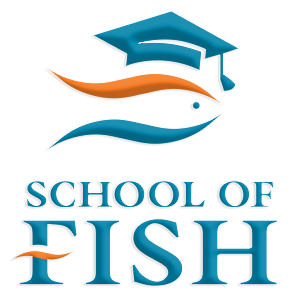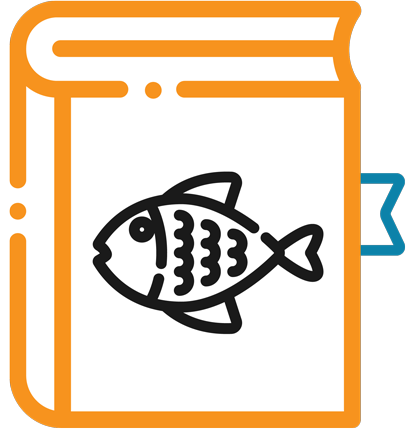
Loading

Seafood health and safety
Understand the benefits. Beware of the risks
Extensive research has been done documenting both the benefits and risks associated with eating seafood.
Unfortunately - this research is often presented in such a way that can be confusing to everyday consumers.
While seafood is a high-protein - low-fat source of a variety of nutrients and Omega-3 Fatty Acids - it can also contain high amounts of contaminants such as - Mercury and Polychlorinated Biphenyls (PCBs).
This section provides insight into the benefits and risks - and clarifies some common myths with respect to seafood health and safety.
In development of this material, the following resources were used:

Nutrients
Optimize your health. Get your fatty acids.
Fish and seafood contain many nutrients that play a role in the daily functions of the human body, including: human growth and development - energy metabolism - building and repairing tissues - formation and maintenance of bones and teeth - formation of red blood cells and building antibodies.
What are Omega-3 Fatty Acids?
Fish and seafood are high in Omega-3 Fatty Acids - often referred to as the “good” fats. The human body cannot make significant quantities of Omega-3 Fatty Acids on its own - highlighting the importance of getting sufficient amounts through food. While there are 6 types of Omega-3 Fatty Acids - the two main types found in seafood are eicosapentaenoic acids (EPAs) and docosahexaenoic acids (DHAs).
What are the health benefits from Omega-3 Fatty Acids found in seafood?
- Typically, fish with a higher oil content are higher in EPAs and DHAs. Health benefits associated with Omega-3 Fatty Acids include:
- Lowered incidence of coronary heart disease
- Regulate blood clotting and vessel constriction
- Help manage diabetes
- Help manage skin disorders
- Reduced cholesterol levels
- Lowered blood pressure
- Reduced lupus symptoms
- Reduced arthritis symptoms
- Prevent and control colitis
- Reduced asthma symptoms
- Increase cognitive ability (memory & focus)
- Halt mental decline in older adults
- Reduced depression severity
- Help manage attention deficit disorder, bipolar and schizophrenia
- Cancer prevention
- Improved immune function
- Important for pre and postnatal neurological development
What are other sources of Omega-3 Fatty Acids?
Other sources of Omega-3 Fatty Acids include: flaxseed - walnuts - soybeans and tofu. However, plant sources of Omega-3 Fatty Acids are not absorbed as readily by the body and therefore may not result in the same health benefits. The majority of fish oil supplements are now made from purified fish oil. Purified fish oils are free of all contaminants present in fish making them a safe alternative - but it is recommended to not consume more than 3 grams per day - unless under physician care.

Contaminants
Understand the risks. Get the facts on contaminants.
Fish and seafood may have health risks due to contamination by Mercury and industrial chemicals - otherwise known as Polychlorinated Biphenyl (PCBs).
Where does Mercury come from?
Mercury is a naturally occurring metal found in soil, rocks and water. In addition, Mercury is released into the atmosphere as a result of human activities such as, coal-fired power generation, metal mining, and waste incineration. Contrary to popular belief, the amount of Mercury in our environment and in the fish we eat is not increasing. In fact, there is evidence that the amount of Mercury in fish has remained the same - or even decreased in the past 100 years.
Is Mercury toxic?
Mercury is toxic - it does not break down in the environment and can build up in living organisms. Traces of Mercury are present in all foods, including fish and seafood. In fish, Mercury converts into its most toxic form - Methyl Mercury. Methyl Mercury levels in fish accumulate in larger species - predatory fish such as Shark, Swordfish, Tuna, Marlin, Pike, Bass and Walleye. Consequently, individuals who consume fish and seafood may be exposed to varying levels of Methyl Mercury.
What are the health effects of Methyl Mercury toxicity?
Research evaluating the health risks of Methyl Mercury toxicity - also known as Minamata disease - is contradictory and inconclusive. The World Health Organization has concluded that "the general population does not face a significant health risk from Methyl Mercury" in the fish we eat and that even fish species with the highest levels of Methyl Mercury don’t contain enough to be harmful. Conversely, other studies have found that health effects of Methyl Mercury toxicity do exist and that severity can depend on the level of exposure and age of the individual exposed.
- Possible symptoms include:
- Tingling of the skin
- Numbness
- Lack of muscle coordination
- Tremors
- Tunnel vision
- Slurred speech
- Skin rashes
- Abnormal behavior (such as fits of laughter)
- Intellectual impairment
- Coma
- Death
Studies have also been done to document the prenatal affects of Methyl Mercury toxicity. These indicate that fetuses are at particular risk for neurological damage from Mercury exposure.
Polychlorinated Biphenyl
Polychlorinated Biphenyls (PCBs) refer to any one of 209 man-made chemicals that are similar in structure. PCBs were first manufactured as industrial materials (caulking compounds, cutting oils, lubricants, paint additives etc.) in the 1920’s. Concern over their environmental impact led the federal government to ban manufacture and import of PCBs and to phase out any PCBs used in current electrical applications.
Trace levels of PCBs are found in the environment and in the cells of animals. Higher concentrations are found in animals at the top of the food chain, including humans. The human average daily dietary intake of PCBs is thought to be less than 0.5 micrograms. People who eat large amounts of sports fish, wildlife or marine mammals may be exposed to higher dietary levels.
-
Adverse health effects caused by high-level exposure to PCBs include:
- Severe acne
- Swelling of upper eyelids
- Discoloring of nails and skin
- Numbness in arms and legs
- Weakness
- Muscle spasms
- Chronic bronchitis
- Problems related to the nervous system
- Increased incidence of cancer, particularly liver and kidney

FAQ's
Maximize the benefits. Minimize the risks.
How much fish and seafood should I eat to get the benefits?
The American Heart Association (AHA) recommends that people eat at least two 3.5 oz servings of fish per week. Canada’s Food Guide recommends individuals consume a similar amount of fish per week, although slightly lower. Individuals with coronary heart disease may need to consume additional Omega-3 Fatty Acids. These people may be directed to take dietary supplements by their physician. No person should consume more than 3 grams of Omega-3 Fatty Acids per day from dietary supplements - unless under physician care.
The Monterey Bay Aquarium states that fish species considered high in Omega-3 Fatty Acids are those that provide at least 0.20 grams/day based a diet of 8 oz. per week. For a 7 oz. (two 3.5 oz. servings) diet per week this is 0.22 grams/day.
What precautions should I take with respect to Mercury exposure?
Despite conflicting evidence - various organizations have recommendations for the general public with respect to Mercury exposure. The US Environmental Protection Agency recommends that a person is exposed to 0.1 ug Mercury per kg body weight per day. This level corresponds to a blood Mercury level of 5.8 ug/L or 5.8 parts per billion. Commonly consumed fish species (Salmon, Cod, Pollock, Sole, Shrimp, Mussels, Scallops and canned Tuna) have Mercury levels far below this limit and are considered safe for consumption. Moreover, this level is far below what is necessary to result in neurological damage to adults - 200 ug/L is associated with a 5% risk.
Children, women of childbearing age, pregnant women and nursing mothers are advised to avoid eating fish species with the highest Mercury contamination levels e.g. Shark, Swordfish, King Mackerel.
Do the benefits of eating fish and seafood outweigh the risks?
Absolutely. Fish are considered an important part of a healthy diet and the benefits of consuming Omega-3 Fatty Acids far exceed the risk of Mercury or PCB exposure. However, as a precaution it is recommended to stay up-to-date on relevant health advisories and to not eat certain types of fish - too often.

Shop: Great seafood recipes - start with great seafood
Whether you are exploring your local fish market or the frozen options in your grocer’s freezer aisle – we have some recommendations to help ensure you make the freshest choice.
In addition to being an excellent source of quality lean protein and a valuable source of essential and beneficial nutrients - seafood is simply delicious!
Explore your options – get inspired with a new recipe - and eat more seafood!

Questions to Ask
What you are really buying? Ask the right questions.
Some great questions to ask:
What type of fish is it - really?
A lot of seafood is mislabeled – Grouper, Red Snapper and Wild Salmon are common culprits. Demand to know the name of the fish.
Where is this fish actually from?
Some countries are known to have stricter management practices than others. For example - Alaska is recognized as a leader in effective fisheries management. Conversely - little is known about management in Russia and some countries in Asia.
Is this fish wild-caught or farm-raised?
Whether the fish is wild-caught or farm-raised can have implications related to environmentalism and can indicate what further questions you may need to ask.
If farmed - how was it grown?
Different forms of aquaculture have varying degrees of environmental concerns. Open-net pens – where farms are in direct contact with the marine environment – are considered less environmentally friendly than closed net pens.
If wild - how was it caught?
Some methods of catch are more environmentally friendly than others. For example - pole caught methods have low by catch rates and few habitat degradation concerns. Conversely - bottom trawling is especially harmful.
Are populations of this fish healthy?
Some fish populations are healthy and abundant - while others are overfished and poorly managed.
What are some sustainable alternatives to this fish?
Some species of fish can be easily substituted in recipes with other - more sustainable species.
How old is the fish?
If you’re buying fresh - don’t settle for anything that has been sitting on the counter for more than one day - or at most a couple of days.

Prep: Knowledge - patience and practice.
Whether you are working with Finfish or Shellfish – the knowledge base and skill set required to safely and effectively clean – portion - store and thaw seafood – is vastly different compared to other proteins.
As in learning any other unique skill – patience and practice make perfect!
Use this section to learn some of the basics and seek additional knowledge from trustworthy sources in your local community and on the internet.

Storage
The key to fresh is - keep it cold.
Like all proteins - seafood is vulnerable to environmental temperature fluctuations. In fact – Finfish and Shellfish are the most perishable foods in any kitchen.
Fresh or frozen - it is important that you store it correctly.
Proper storage will ensure that you prolong freshness and minimize opportunity for spoiling and bacterial contamination.
- The key objectives in storing fresh seafood are:
- maintain temperature at -1°c to +1°c
- keep fish moist
- prevent odours and flavours from transferring to other foods
- protect the delicate texture from being crushed or bruised

Thawing
In the fridge - not on the counter.
- Do not thaw Finfish or Shellfish at room temperature. Both should be thawed in the refrigerator for approximately 18 to 36 hours.
- If you must expedite the thawing process – with Finfish - place the fish under cold running water - in its original moisture proof packaging.
- With Shellfish – place the container under cold running water or in a cold water bath.
- Small portions of fish can be cooked from the frozen state.
- Once your fish is thawed – handle it as though it is fresh.
- Never re-freeze fish.
- If the seafood was commercially frozen - the product will likely come with detailed thawing instructions. We recommend that you review them and follow them diligently.

Cook: Frustrated by cooking fish? You are not alone.
The main reason home chefs are challenged by cooking seafood is that they approach it the same way they would other proteins.
This simply does not work.
The fundamental structure of the flesh in fish is vastly different than the flesh of other meats including beef – pork – lamb and poultry.
Read on and learn the key to delivering delicious seafood recipes to your table.

The Key
Be gentle – and turn down the heat.
The key difference between most animal proteins and seafood is in the connective tissue – or actually – the lack there of.
- Less connective tissue impacts cooking in the following ways:
- Flesh cooks very quickly – even with a low temperature heat source.
- Flesh is naturally tender – high heat only toughens the proteins in the flesh when cooking.
- Rough handling of cooked fish causes the flesh to break apart very easily.
Remember - be gentle when cooking and serving.

Doneness
Secret of the perfect flake? Beware of retained heat.
Unlike other proteins – when fish flesh is cooked – it breaks apart naturally into pieces or flakes.
Most cook books will tell you to cook until the flesh "flakes easily".
Easier said than done
Heat retained in the flesh – even when the fish has been removed from the heat source – will continue to cook the fish for a period of time.
Depending on the variety of fish and the desired doneness – this can turn "flakes easily" into "disintegrating"s – in a very short period of time.
- Fish is cooked when:
- Flesh is just beginning to separate.
- When bone-in – flesh begins to fall off the bone – the bone is white and has lost its pinkish tone.
- Flesh has just turned from translucent to opaque.

Oil Content
Dry heat or moist heat? It depends on the natural oil content.
To maximize success – your choice of cooking method should reflect the natural oil content of the fish.
Fatty fish – such as Salmon – Tuna – Trout and Mackerel are more resilient to high heat than their leaner cousins.
Lean fish – such as Halibut – Cod – Sole and Haddock are less resilient to high heat than their fattier cousins.
Lean fish is better suited to moist heat methods.
If you choose to use a dry heat method – it is recommended that the fish be basted with an oil based liquid such as olive oil, vegetable oil, butter or a marinade – and be VERY careful to not overcook.


Methods
Bored of the usual? Try something new!
Salmon
Salmon is a delicious, healthy and versatile fish that can be enjoyed for breakfast, lunch or dinner. Some popular methods of cooking Salmon include:
cedar planks – cedar planked Salmon is a Native American cultural tradition that evolved in the Pacific Northwest many generations ago. This simple method of grilling fish enhances the flavour by adding a delightfully smokey taste!
poached - poaching is quite simple and can be done in a matter of minutes. The option to use many different types of sauces allows you to create a new experience - every time.
smoked - smoked Salmon may take a bit longer to prepare, but is perhaps one of the most popular ways to enjoy this delightful fish. Smoking Salmon adds flavour and preserves the fish - allowing you to enjoy it later in the week as an appetizer - or as a cold breakfast or lunch.
grilled - grilling Salmon is probably the easiest way to enjoy this delicious fish. Whether you use a barbeque, a pan or an indoor grill - this method always results in a delicious meal. Many grocery stores offer pre-made marinades and seasonings - or you can be creative and make your own!
White Fish
There are many types of Whitefish available for you to experiment with in your home kitchen. From the rich and sweetly flavoured Sablefish - to the light and mildly flavoured Halibut – Whitefish can be cooked many ways and with a variety of sauces to suit your tastebuds.
pan-fried – this method of cooking can be used for a wide variety of species including Halibut - Tilapia and Cod. Pan-frying is a useful way to prevent Whitefish from drying out and at the same time it presents the opportunity to combine fish with a variety of sauces - creating a juicy and succulent meal!
battered - if you are a fan of the ever-so-popular English-style Fish & Chips - then you will love trying battered Whitefish in your home kitchen. Virtually any type of Whitefish can be battered including Halibut - Cod - Rockfish - Pangasius and even some types of Shellfish.
baked - Baking Whitefish is probably the best option if you’re looking to incorporate a stuffing, or if you are just more comfortable working with your oven. There are hundreds of recipes to try and by using foil your clean up will be literally non-existent!
ceviche - not to be confused with “cooking” - Ceviche is a way of serving raw seafood that’s been marinated in citrus juice. The citrus pickles the fish making it taste as though it has been cooked. Ceviche is native to Peru and is very popular in South and Central America – recently it has also gained popularity in North America.
Shellfish
There is a common misperception that Shellfish is difficult to cook and as a result - many consumers shy away from Shellfish at the fish counter. The truth is that Shellfish can be the easiest - and the quickest - type of seafood to cook.
steamed – Whether you are eating Crab, Lobster, Mussels or Clams - steaming your Shellfish in a delicious broth is a quick and easy way to impress your dinner guests.
boiled - Lobster and Crab are commonly boiled in restaurants and in home-kitchens. Boiling is very similar to steaming in that it is quick, easy and convenient.
pan-seared - Possibly one of the best ways to cook Scallops – pan-searing can be used with a variety of sauces to suit your taste.
skewered - Skewers are a delicious and fun way to enjoy Shellfish. Especially popular with Shrimp and Squid - throwing skewers on the grill gives you the chance to enjoy fresh Shellfish and seasonal vegetables all in one bite!





